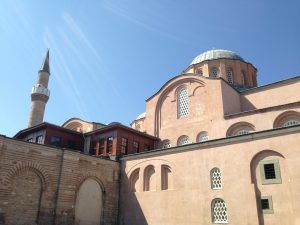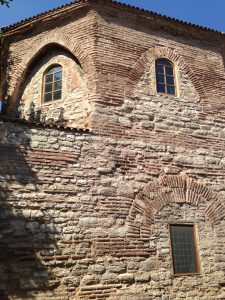Once a desperately poor neighbourhood, Zeyrek is the area on the western side of İstanbul’s Atatürk Bulvarı which is dominated by the vast Church of the Pantocrator (Zeyrek Cami). Until recently it was fairly run-down but gentrification has been proceeding rapidly as many of its old wooden houses are restored. A clear sign of changing times was the reopening in 2024 of the beautiful Çinıli Hamamı after expensive restoration by the Marmara group.
Zeyrek takes its name from Molla Zeyrek, a holy man and pupil of Hacı Bayram Veli who founded a medrese here in the 15th century. As its fame spread, more Muslims came to live here and the old Greek population relocated to Galata on the other side of the Golden Horn.
 Church of the Pantocrator
Church of the Pantocrator
What is now Molla Zeyrek Cami started life as the Byzantine Church of the Pantocrator in the early 12th century. It stands in a small square backing onto a bluff offering a magnificent view towards the Golden Horn. Until recently it was in an advanced state of dereliction but the large complex has now been completely restored to serve as a mosque.

The church-mosque started life as two separate churches linked by a memorial chapel to the Komneni family. They were once part of a large complex incorporating two hospitals and a retirement home but these ancillary buildings no longer survive; only what John Freely identified in Strolling Through Istanbul as a possible library or funerary chapel lives on in the form of the octagonal Şeyh Şuleyman Mescid.
The northerly church, dedicated to the Virgin Elousa, was commissioned by the Empress Eirene, while the southerly one, dedicated to St Saviour Pantokrator, was commissioned by the Emperor John II Komnenos. Both appear to have been built between 1120 and 1136.
Many of the great monastery’s treasures were stolen during the Latin Interregnum following the Fourth Crusade of 1204; part of the Pala d’Oro in Venice’s St Mark’s Basilica is believed to have come from Zeyrek. Today only a few carvings survive to suggest what must have been considerable internal splendour. The fine opus sectile (mosaic) floor uncovered in the 1950s is sadly hidden beneath new carpeting.
To find the complex walk up Atatürk Bulvarı towards the Aqueduct of Valens and then turn right beside the Zeyrek Sarnıçı, a brick-built cistern with a curvy external wall which has been restored but is not yet open to the public.
Around Zeyrek
In the Zeyrek back streets lurks the small 11th-century Church of St Saviour Pantepotes (Christ the All Seeing) which was used as a soup kitchen during the years when Fatih Cami was being built, hence its name, the Eski İmaret Cami (the Old Soup Kitchen Mosque). To see inside it you usually need to visit around the time of prayer services.

Instead of heading along Atatürk Bulvarı and up to the church-mosque you can cut up İtfaiye Caddesi behind the buildings of the SSK (Sosyal Sigortalar Kurumu), an award-winning design by Sedad Hakkı Eldem (1908-88). The picturesque street slopes gently up to the Kadınlar Pazarı/Fatih Pazar, passing the magnificent Çinili Hamamı (Tiled Hamam), a work of Sinan dating back to 1546 and with separate sections for men and women. On the way you will pass the Zenbelli Ali Baba Sibyan Mektebi (primary school) commissioned by the Şeyhülislam Ali bin Ahmed Efendi who died in 1525 and is buried in the garden.
Recently restored and waiting to be reopened to bathers, the Çinili Hamam comes with a small museum (closed Mondays, admission TL150) that describes its restoration and the discovery of many fragments of the İznik tiles that once lined its walls and gave rise to its name. A fine collection of the nalin (tall wooden clogs) on which women used to totter around the baths is also on display along with contrasting reproductions of Ottoman and Western images of hamam interiors. A lift gives access to a small cistern under the bathhouse where graffiti of galleons in full sail can be seen etched into the plaster. Before restoration, this was the hamam that featured in Ferzan Özpetek’s 1997 film Hamam.
Transport info
Catch any bus from Eminönü to Fatih via Atatürk Bulvarı and get off halfway up the hill. The nearest tram stop is Cibali beside the Golden Horn. The walk up the hill is relatively steep and traffic-clogged.
Nearby areas

